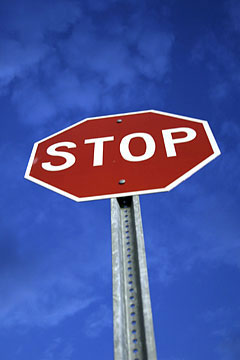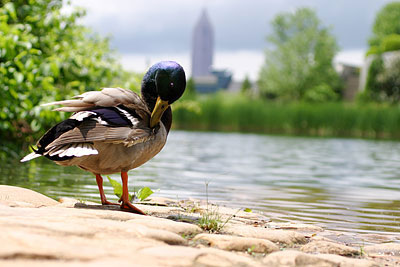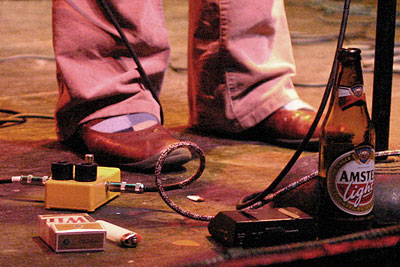AnandTech Guide to Better Photos: Composition
by Stephen Caston on November 19, 2004 12:05 AM EST- Posted in
- Digital Camera
More Ideas
In addition to the compositional concepts, which we have already mentioned, there are a few more points that we would like to bring up. Something that rarely occurs to people is the importance of perspective when shooting. If many of your shots are taken at eye level while standing, they will all have a similar "look" to them. However, if you experiment with different camera angles and perspectives, you will probably find that the results are far more interesting than "standard" perspective pictures.
In the picture above, we used a low angle approach to highlight the strong contrast between the dark red stop sign and the dark blue sky. By using this low angle, we were able to simplify the image by removing distracting background elements that would have appeared in a "standard" perspective shot.

Don't hesitate to get down on the ground. In this picture, we were able to contrast this duck against the Atlanta cityscape by lying on the ground by this pond.
One of the most important things to keep in mind with composition is to stay creative. Experiment with different angles and compositions that you haven't tried before. With a digital camera, there is absolutely no excuse for a lack of experimentation. If the picture turns out bad, you can just delete it before anyone else sees it. This is really the only way to develop an eye for your unique photographic style.
Another way to build your compositional awareness is to look for pre-existing compositions around you. Bring your camera with you whenever possible and you may find some unlikely subjects.

For example, at this concert, something struck us about the circular arrangement of this singer's feet, the beer bottle, cigarettes with a lighter, and effects pedal. If you see "naturally" occurring compositions, you may feel compelled to photograph them and this is a great way to experiment with different composition ideas.
On a similar subject, we want to challenge you to take good pictures of ordinary things. Too many people think that to take an interesting picture, you must have interesting subjects. A good example of this line of thought is that people are often waiting to see something present itself as a "photo op". This passive way of thinking is sure to present you with few pictures and very little experience. The real challenge is to exercise your ability to turn any situation into an opportunity for good pictures. So please, especially if you have a digicam, shoot away and try out new things. You have absolutely nothing to lose. The worst that you can do is improve your photographic ability.
Hopefully, you've been able to take something from this first article of our AnandTech Guide to Better Photos. At the very least, we hope that you will become more aware of your composition when shooting. The smallest adjustments can make the biggest differences in your pictures. With this article, our goal is to make you aware of some basic concepts for improving your own photography. Keep in mind, though, that all the theory in the world won't produce better pictures - only shooting can do that! In our next article, we will take a look at some techniques for taking great portrait pictures. Until then, get out there and compose!










25 Comments
View All Comments
Maverick2002 - Friday, November 19, 2004 - link
I have to agree with #5. It's a good beginner's guide, nothing more.Jeff7181 - Friday, November 19, 2004 - link
I found it very informative... like #10, I find my pictures are usually boring and I'm not creative at all. Most photography sites don't discuss the basics of composition. The pictures I take that turn out good are mostly by accident... I'm the type who centers whatever I'm taking a picture of and snaps the picture. Or if I'm taking a picture of something larger like a landscape, I just point and shoot without giving much thought to what's in the picture. I'm not REALLY into photography obviously, but when I do take pictures I'd like them to look nice.yelo333 - Friday, November 19, 2004 - link
Very nice pointers...do you happen to have higher res versions of the photos? I especially liked the ladybug&stop sign for some reason...If you don't mind emailing them(I'd only use them for personal use, like wallpaper), my email is gmeena at gmail dot com.
WooDaddy - Friday, November 19, 2004 - link
#11 said it.This is who the article was for. Not the rest of us camera jockeys who can go through a roll of 36 in 30 minutes.
CurtOien, if you really want to get into it, take a camera course at your local community college. Also, check out "Photography" by Barbara London. It's the photography student's textbook.
And remember, just keep on taking pictures and examining them. That's how you get good at it.
CurtOien - Friday, November 19, 2004 - link
I’m not a professional photographer or even close to it. I very much appreciated the article. It makes me want to go out and buy a digital camera It costs too much money to click away and experiment with film.ChrisSwede - Friday, November 19, 2004 - link
I agree with #5 that this will not make you a professional photographer. But, for someone like me that struggle to take good pictures and do not have a single creative/artistic bone in me, it gives me some hints on how to improve picture quality and get a little excited about taking pictures./Chris
Calin - Friday, November 19, 2004 - link
#5, you are completely right. However, I am glad for this article as I didn't knew not even a single thing in it. Yes, I am not a photographerCalin
skunklet - Friday, November 19, 2004 - link
i was hoping u guys gave up on these photography articles...kcma - Friday, November 19, 2004 - link
#6brilliant idea!! eat the mattress!! i like them BBQed.
Dustswirl - Friday, November 19, 2004 - link
You can't explain how to sleep to an insomniac but you can show him a bed.